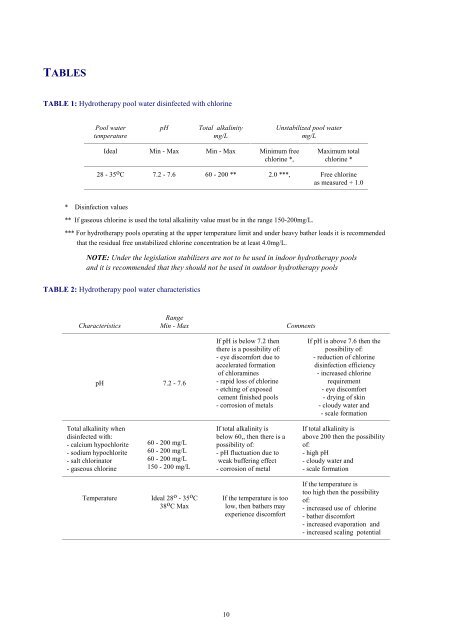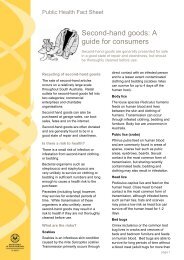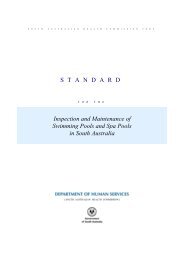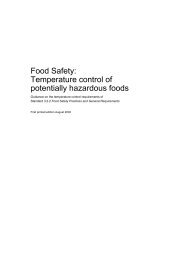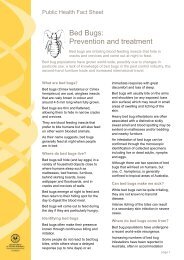Standard for the Operation of Swimming Pools and Spa ... - SA Health
Standard for the Operation of Swimming Pools and Spa ... - SA Health
Standard for the Operation of Swimming Pools and Spa ... - SA Health
Create successful ePaper yourself
Turn your PDF publications into a flip-book with our unique Google optimized e-Paper software.
TABLES<br />
TABLE 1: Hydro<strong>the</strong>rapy pool water disinfected with chlorine<br />
Pool water<br />
temperature<br />
* Disinfection values<br />
pH Total alkalinity<br />
mg/L<br />
Ideal Min - Max Min - Max Minimum free<br />
chlorine *,<br />
10<br />
Unstabilized pool water<br />
mg/L<br />
Maximum total<br />
chlorine *<br />
28 - 35 o C 7.2 - 7.6 60 - 200 ** 2.0 ***, Free chlorine<br />
as measured + 1.0<br />
** If gaseous chlorine is used <strong>the</strong> total alkalinity value must be in <strong>the</strong> range 150-200mg/L.<br />
*** For hydro<strong>the</strong>rapy pools operating at <strong>the</strong> upper temperature limit <strong>and</strong> under heavy ba<strong>the</strong>r loads it is recommended<br />
that <strong>the</strong> residual free unstabilized chlorine concentration be at least 4.0mg/L.<br />
NOTE: Under <strong>the</strong> legislation stabilizers are not to be used in indoor hydro<strong>the</strong>rapy pools<br />
<strong>and</strong> it is recommended that <strong>the</strong>y should not be used in outdoor hydro<strong>the</strong>rapy pools<br />
TABLE 2: Hydro<strong>the</strong>rapy pool water characteristics<br />
Characteristics<br />
pH<br />
Total alkalinity when<br />
disinfected with:<br />
- calcium hypochlorite<br />
- sodium hypochlorite<br />
- salt chlorinator<br />
- gaseous chlorine<br />
Temperature<br />
Range<br />
Min - Max<br />
7.2 - 7.6<br />
60 - 200 mg/L<br />
60 - 200 mg/L<br />
60 - 200 mg/L<br />
150 - 200 mg/L<br />
Ideal 28 o - 35 o C<br />
38 o C Max<br />
If pH is below 7.2 <strong>the</strong>n<br />
<strong>the</strong>re is a possibility <strong>of</strong>:<br />
- eye discom<strong>for</strong>t due to<br />
accelerated <strong>for</strong>mation<br />
<strong>of</strong> chloramines<br />
- rapid loss <strong>of</strong> chlorine<br />
- etching <strong>of</strong> exposed<br />
cement finished pools<br />
- corrosion <strong>of</strong> metals<br />
If total alkalinity is<br />
below 60,, <strong>the</strong>n <strong>the</strong>re is a<br />
possibility <strong>of</strong>:<br />
- pH fluctuation due to<br />
weak buffering effect<br />
- corrosion <strong>of</strong> metal<br />
If <strong>the</strong> temperature is too<br />
low, <strong>the</strong>n ba<strong>the</strong>rs may<br />
experience discom<strong>for</strong>t<br />
Comments<br />
If pH is above 7.6 <strong>the</strong>n <strong>the</strong><br />
possibility <strong>of</strong>:<br />
- reduction <strong>of</strong> chlorine<br />
disinfection efficiency<br />
- increased chlorine<br />
requirement<br />
- eye discom<strong>for</strong>t<br />
- drying <strong>of</strong> skin<br />
- cloudy water <strong>and</strong><br />
- scale <strong>for</strong>mation<br />
If total alkalinity is<br />
above 200 <strong>the</strong>n <strong>the</strong> possibility<br />
<strong>of</strong>:<br />
- high pH<br />
- cloudy water <strong>and</strong><br />
- scale <strong>for</strong>mation<br />
If <strong>the</strong> temperature is<br />
too high <strong>the</strong>n <strong>the</strong> possibility<br />
<strong>of</strong>:<br />
- increased use <strong>of</strong> chlorine<br />
- ba<strong>the</strong>r discom<strong>for</strong>t<br />
- increased evaporation <strong>and</strong><br />
- increased scaling potential


